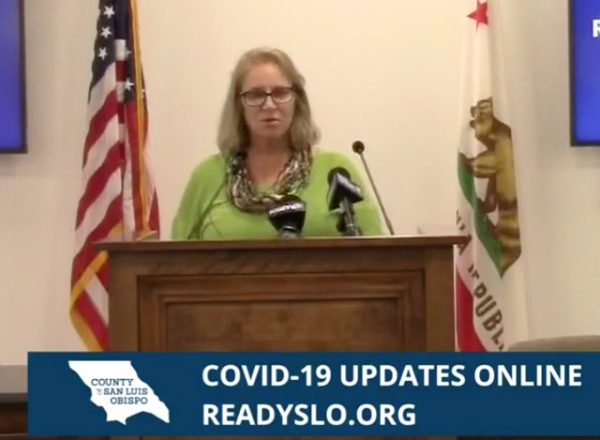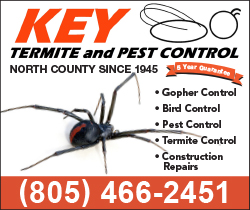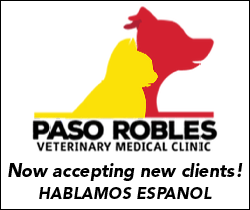COVID-19 update: 21 cases now confirmed in county – see new details

San Luis Obispo County Public Health Officer Dr. Penny Borenstein speaking to the news media and public on Saturday afternoon.
–On Saturday at 3:30 p.m., the County of San Luis Obispo went live on Facebook to discuss the latest updates regarding the COVID-19 pandemic. At this time, 21 local residents have tested positive for the COVID-19 coronavirus, according to County Public Health Officer Dr. Penny Borenstein. The press conference was held at the county’s Joint Information Center at 1133 Kansas Avenue, San Luis Obispo, Calif.
At this time, one COVID-19 patient has been admitted to a local hospital, while the others are recovering at home, Borenstein said. Hospital capacity for new cases in the county is good, Borenstein said. Testing capacity is also good, she said. “We continue to meet the demand for high priority cases.”
Distribution of COVID-19 cases in San Luis Obispo County
- North County cases – 9
- Coastal County cases – 3
- San Luis Obispo central cases – 1
- South County cases – 7
- Not reported – 1
Ages of COVID-19 cases in San Luis Obispo County
- Age 19-64 years old – 11
- Age 65 years or older – 9
- Not reported – 1
Source of transmission of COVID-19 cases in San Luis Obispo County
- Travel related transmission – 12
- Known person-to-person transmission – 5 (most in households)
- Unknown community-acquired transmission – 2
- Remainder unknown
As of Saturday afternoon, the county has conducted nearly 300 tests. As of Friday afternoon, an additional lab that has been testing local patients from both San Luis Obispo County and Santa Maria has tested 282 samples. The county health lab detected 13 positive cases, and 7 cases were reported by private laboratories to the county.
While Borenstein had previously reported that infants and children are at low risk of infection, she said new data shows that young people are contracting the virus, though none in San Luis Obispo County to date.
More guidelines regarding the current “Shelter at Home” order and other information are available at readyslo.org. The county order remains in effect, business operations are limited to essential services. See the list of businesses that are allowed to stay open under the county order.
The county asks residents to only purchase grocery items needed and not to hoard. Supply chains to local stores are in good condition, the county reports. No evictions of renters affected by the pandemic will be permitted at this time, the county says.
The county asks residents to maintain a distance of six feet between other people while waiting In line at grocery stores, pharmacies, or engaging in recreational activities.
In nearby counties, as of Saturday afternoon, there were 11 confirmed cases of COVID-19 among Monterey County residents and one death, and 11 cases in Santa Barbara County.
Additional information from the county and state below:
County issues amendment to shelter at home order
The executive order to Shelter At Home issued by County Emergency Services Director Wade Horton on March 19, 2020, has been amended to provide additional clarity for residents and businesses.
The amendment to the Shelter At Home Order establishes definitions for “Minimum Basic Operations” and “Essential Travel” which will clarify allowable business operations and travel. The emergency order remains in effect until April 17, 2020. It will be reviewed every 14 days to evaluate the need to continue the order. The intent of the order is to slow the spread of coronavirus disease 2019 (COVID-19) in San Luis Obispo County by ensuring that the maximum number of people self-quarantine in their places of residence to the maximum extent possible, while enabling essential services to continue.
Read a copy of SLO County’s Shelter At Home order amendments.
Food and medication resources for seniors or self-isolating residents
Self-isolating San Luis Obispo County residents 65 and older and those with chronic medical conditions who can’t get to the grocery store or pharmacy now have a free way to get their food and medicine delivered.
The County of San Luis Obispo’s no-cost Food and Medication Resource Plan focuses on delivering food and prescription medication to those who need it most. “We need to take care of our community and ensure that the basic needs of our most vulnerable residents are met during this time,” says County Emergency Services Director Wade Horton.
To tap into the service, residents can take a short survey to assess needs around the clock at ReadySLO.org, or by calling the Phone Assistance Center at (805) 543-2444. Phone service is accessible seven days a week from 8 :00 a.m. to 5 :00 p.m. Once the need is assessed and approved, the County will make a follow-up call with the requestor to coordinate delivery details.
Provided groceries will include dry goods, protein, and a selection of fresh produce. The grocery deliveries are intended to last one person 3-7 days. However, requests can be made for multiple people. If prescription medication is needed, the requestor will need to submit the prescription(s) to the pharmacy of their choice to be filled and pay for the prescriptions directly with the pharmacy prior to the scheduled delivery. The groceries and delivery will be provided at no cost. Most pharmacies are providing free delivery of prescription medications as well.
A no-contact delivery will be provided; County staff will knock on the door or ring the bell and leave the bagged delivery at the door. General food safety practices will be followed.
Community members who are under age 65 and are not receiving ongoing medical care should continue to visit essential businesses as necessary.
COVID-19 in California by the numbers
The following state information received from local health jurisdictions as of 2 p.m., March 20, 2020.
- 1,224 – Positive cases
- 23 – Deaths
- 96 – Travel-related cases
- 122 – Person to person cases
- 325 – Community transmission cases
- 657 – Under investigation
- 24 – Positive cases related to federal repatriation flights
Ages of all confirmed positive cases in California
- Age 0-17: 19 cases
- Age 18-64: 876 cases
- Age 65+: 321 cases
- Unknown: 8 cases
Testing in California
As of 2 p.m., March 20, approximately 25,200 tests had been conducted in California. This includes the latest numbers California has received from commercial and private labs. At least 12,528 results have been received and another 12,700+ are pending. Twenty-two state and county health labs are currently testing.
What is the cause of COVID-19 transmission
Transmission of the COVID-19 virus appears to be caused by close and prolonged contact, Borenstein said. The greater the illness has affected someone, the more likely they are to transmit it to other people, she said. Asymptomatic transmission, if occurring at all, is a minor proportion of infections, she said. Airborne infection appears to be limited to someone infected who coughs or sneezes and vapor droplets may linger for a short period of time. But neither asymptomatic transmission nor airborne transmission appear to be a dominant means of transmission, she said. The virus does tend to transfer well with human contact, like shaking hands, and linger on hard surfaces, studies have shown.
How can people protect themselves
Every person has a role to play. Protecting yourself and your family comes down to common sense:
- Staying home except for essential activities – “Shelter at home“
- Washing hands with soap and water for a minimum of 20 seconds.
- Avoiding touching eyes, nose or mouth with unwashed hands.
- Cover a cough or sneeze with your sleeve, or disposable tissue. Wash your hands afterward.
- Avoiding close contact with people who are sick.
- Staying away from work, school or other people if you become sick with respiratory symptoms like fever and cough.
- Practicing social distancing.
- Following guidance from public health officials.
What to do if you think you’re sick
Call ahead: If you are experiencing symptoms of COVID-19 (fever, cough or shortness of breath) and may have had contact with a person with COVID-19, or recently traveled to countries with apparent community spread, call your health care provider before seeking medical care so that appropriate precautions can be taken.
San Luis Obispo County’s urgent communicable disease line is (805) 781-4553.
- Follow all local COVID-19 coronavirus news updates
- List of businesses that are allowed to stay open under county COVID-19 order
- North County restaurants, wineries, and services are open for business and ready to serve
- New York Times US map and statistics of COVID-19 cases
- San Luis Obispo County COVID-19 website – readyslo.org
- Gov. Gavin Newsom’s Saturday evening update to Californians
Comments
Scott Brennan is the publisher of this newspaper and founder of Access Publishing. Follow him on Twitter, LinkedIn, or follow his blog.






















